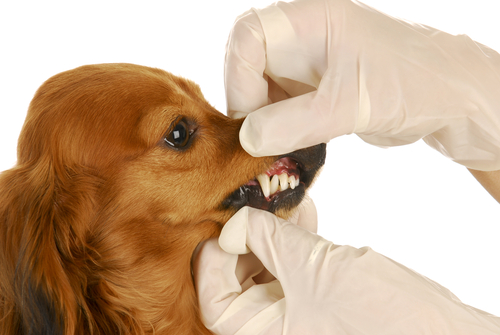
"What do you look for during a dental exam?"
February is dental month at Bishop Ranch Veterinary Center & Urgent Care! Ever wonder what we look for when we ask your pet to say "ahhhh"? Below, I will go over some of the more common things that affect the teeth of cats and dogs. I recommend owners perform their at-home evaluations of their pet's teeth monthly – if you see any of these things, bring your pet in so we can discuss the best next steps.
At-home oral exams are always a good idea.
To do an oral exam, the best way to start is to look at the teeth from the side. The easiest way is to pull the corner of your pet's lips back with your thumb while holding the upper lip up with your other hand. Check all the teeth and the gums (if they are darker pink or red along the tooth, it's a sign of gingivitis). The worst disease is usually on the teeth in the back of the mouth, so look there. Once you've looked at both sides, open the mouth to look at the tongue, lips, and back of the throat for abnormal growths or masses.
Tartar and calculus
The rough, raised yellow and brown material sticking to your pet's teeth are tartar and calculus. We look at these primary indicators to determine if your pet has periodontal disease. Follow this link to learn about the most common dog and cat mouth disease.
Discolored/abnormally colored teeth
The vast majority of discolored teeth are dead, which result from either trauma or infection. You see discoloration from bleeding inside the tooth, changing color from normal white to pink, purple, or brown.
Fractured (broken) teeth
The most commonly broken teeth are the canine teeth (in dogs and cats) and the upper fourth premolar (carnassial) teeth (in dogs). Broken teeth are most often the result of chewing on hard objects (such as bones or rocks) but can also be seen with trauma. When the tooth breaks, the root canal is exposed, which causes a significant amount of pain. It also allows bacteria to enter and infect the tooth. Down the road, this can cause a tooth root abscess or infection of the tooth root.
Retained baby teeth
These are most commonly seen in small and toy dog breeds and brachycephalic breeds such as bulldogs and pugs. For some reason, baby teeth do not fall out in these breeds. They will instead stay where they are, which leads to two problems:
1) It may cause the adult tooth to erupt at an abnormal angle, causing a malocclusion (misalignment of the teeth).
2) The placement of the adult and baby teeth provides the perfect conditions for plaque/tartar accumulation, leading to severe periodontal disease and, eventually, the loss of both teeth.
One reason we recommend waiting to spay or neuter until 6 months of age is that we can determine whether we also need to remove any retained baby teeth.
Feline stomatitis
Seen as widespread severe oral inflammation of the gingiva (gums) and back of the mouth, feline stomatitis is a frustrating disease to treat. It is extremely painful – cats may have difficulty eating, drool, groom less, or be less social. Unfortunately, the exact cause of stomatitis is unknown. However, a common theory is that the cat's immune system is overreacting to the bacteria within the plaque. Therefore, treatment is aimed at keeping plaque levels as low as possible via regular, thorough dental cleanings (removal of plaque above and below the gumlines) and other medications to manage the immune response. In some cases, however, full-mouth extractions are the only thing that relieves these cats.
Feline Oral Resorptive Lesions (FORLs)
In a recent study, 72% of cats over five years of age had at least one of their teeth affected by this disease. Odontoclasts (cells responsible for resorbing/eating away the bone) are activated, causing erosion/loss of the tooth. They most commonly occur at or just below the gumline. They are extremely painful – jaw spasms or teeth chattering can be seen when lightly touched. Dental X-rays are essential in these cases, as they determine how we treat them.
Dr. Stefanie Wong is a graduate of the Veterinary School at Cornell University in Ithaca, NY. Prior to veterinary school, she completed her undergrad at UCLA and graduated magna cum laude with a B.S. in Ecology, Behavior, and Evolution. She spent time in the rainforests of Nicaragua studying the poison dart frog. Also, she spent three months living and working in rural villages in Tanzania with the non-profit Support for International Change. Dr. Wong completed a rotating internship at VCA West LA in Los Angeles, and her special interests include soft tissue and orthopedic surgery, emergency medicine, and dentistry. She is a San Ramon native and loves to spend time outdoors running, surfing, snowboarding, hiking, and kayaking.
Tags: oral exam, Ask the Vet, feline stomatitis, dental disease, tartar, plaque, feline oral resorptive lesions.







